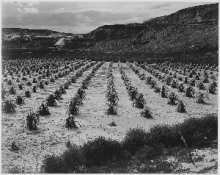Article
A cultural mythology consists of the collected body of narratives that form the base for a world view, philosophy, and religion of a particular culture. Such narratives, or myths, tell stories that often mix supernatural or legendary beings and events with recorded historical ones to allegorically explain the origin, shared history, customs, and religious practices of a given group of people. These stories are passed on through the generations, providing a unifying cultural frame of reference, as well as a basis for social structures, spiritual beliefs, moral standards, and behavior models.
The Hopi people of what is today northern Arizona have a distinct belief system that is based on an origin story and provides the basis for spiritual traditions and the moral codes of social life. In some versions of the Hopi belief system, it is said that the ancestors of the Hopi traveled through three caves into the fourth world, Earth. In each cave they found different important portions of their religion and lifeways. In the first cave they found agriculture, in the second manufacturing, and in the third spirituality. They emerged into the fourth world in the Grand Canyon, which was covered in water. This water was cleared by deities, and the Hopi followed a path set for them by Maasaw, god of death, into the land where they now reside.
Similar to many people, with living traditions that are thousands of years old, Hopi can be very tradition-oriented, incorporating a deep ceremonialism into their lifeways. This practice entails a faith that if their ceremonials are performed with precision, regularity, and faith,the natural cycle will bring rain and all living beings will prosper. Without the necessary observances and living practice of their traditions, the consequence could be a lack of rain and the destruction of the fourth (current) world.
There is a specific Hopi calendar that is based on the splitting of the year and the world into halves that represent opposites such as day/night, summer/winter, and birth/death. These opposing forces define the belief in the coexisting of mirroring worlds. The progression of seasons in the upper (visible) world is reversed in the lower world, where people are reborn after death and occupy a different, invisible realm. The opposing forces also dictate the appearance of the kachinas (and the masked dancers who represent them) in ceremonies throughout the year. For the most part, the calendar is the same across the major villages, but small differences exist with regards to some rituals.
"Corn Field, Indian Farm near Tuba City, Arizona, in Rain, 194" by U.S. National Archives and Records Administration is licensed under Public Domain.
Manuscripts
References
Courlander, Harold
1971 The Fourth World of the Hopis. Greenwich: Fawcett Publications.
Loftin, John D.
2003 Religion and Hopi Life, 2nd ed. Bloomington: Indiana University Press.
Page, Susanne and Jake Page
1982 Hopi. New York: Abrams.
Waters, Frank, and Oswald White Bear Fredericks
1963 Book of the Hopi. New York: Viking Press.

